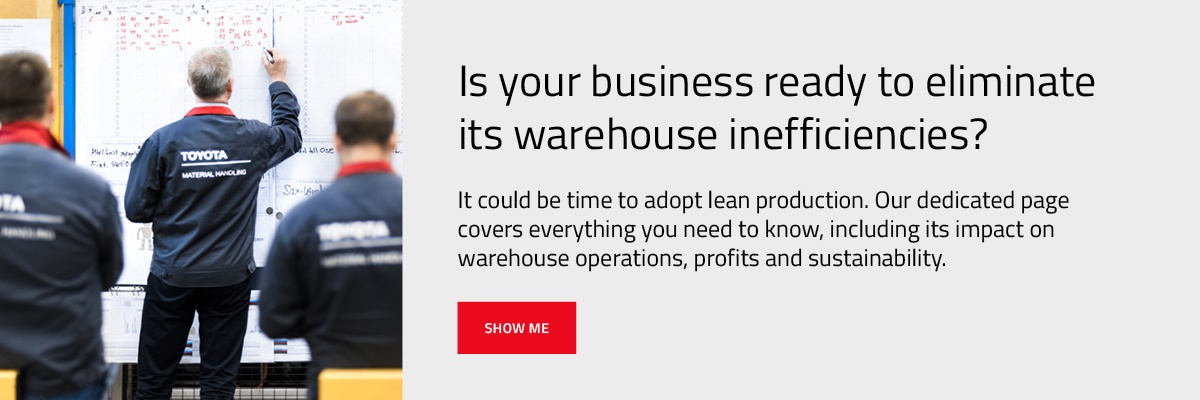Lean is a management approach that focuses on cutting out waste while ensuring quality at the same time. By implementing lean techniques, warehouses can become more sustainable, simultaneously improving their brand reputation and bottom line.
However, these are just a few of the many benefits businesses can reap from implementing lean techniques. We will delve into some more in this article.
- Improved warehouse performance.
- Better inventory management.
- Less space is required in the warehouse.
- Fewer machine and process breakdowns.
- Improved lead times.
- Increased profitability.
- Build a happier workforce.
- Improved customer satisfaction.
- Build a safer warehouse.
1. Improved warehouse performance.
Shipping errors, incorrect levels of stock, lack of organisation — all of these issues ultimately lead to customer dissatisfaction and a loss of sales.
Lean production tools and techniques are designed to help warehouses overcome these challenges. These include automated picking technologies, warehouse management systems and automated guided vehicles. With the use of these technologies, you can help to streamline your processes and reduce your impact on the environment, as these pieces of equipment operate on battery power and produce zero emissions.
Learn more about the power of automation and how it can improve the performance of a warehouse in our insightful guide.
2. Better inventory management.
Managing inventory effectively is one of the cornerstones of building a successful warehouse. Thankfully, lean manufacturing techniques and software are available to support you in your efforts.
For example, ‘Just-in-time’ manufacturing is when material use and inventory are optimised to reside at a level that matches the demand.
Adopting an ERP system can also help you manage your inventory better. These systems make it much easier to track stock levels in real-time.
3. Less space is required in the warehouse.
One way businesses can reduce waste is by optimising their warehouse space. There are specific lean techniques that can support your business regarding warehouse layout optimisation.
These techniques involve developing clear and efficient paths, eliminating redundant processes and reducing lost time spent travelling through traffic.
You can learn more about some of the best practices for warehouse layout optimisation here.
4. Fewer machine and process breakdowns.
It is only natural for machines to break down from time to time. What is important is you have processes that prepare you for when this happens.
The 5S methodology is a systematic approach to workplace organisation and is considered one of the lean production principles.
This method includes the five steps of sort, set in order, shine, standardise and sustain. By implementing the method into an operation, businesses can become more organised and better placed to overcome process breakdowns.
5. Improved lead times.
Better inventory management, fewer machine breakdowns — these benefits combine to streamline the production cycle and ultimately improve lead times.
Lean production is focused on removing non-value-added steps that create waste in the production cycle. By eliminating these steps, fewer issues will arise, and ultimately, lead times will improve.
6. Increased profitability.
Wasted material, time and energy will likely negatively impact your business' bottom line. Lean techniques aim to reduce these types of waste and eliminate the impact they can have on your profitability.
For example, Kaizen is an approach that helps warehouses ensure maximum quality, fast track waste elimination and improve efficiencies, both in terms of equipment and work procedures.
The six big losses is another lean tool used in warehousing to establish the most common waste areas in an operation and make relevant changes to reduce them. These losses can be broken into three categories: availability, performance and quality.
7. Build a happier workforce.
Boosting morale and improving employee engagement are two vital elements of a successful warehouse operation. One of the fundamental beliefs of lean is to promote shared leadership in the workplace.
The lean technique, Kaizen, aims to humanise the workplace by empowering individual members to identify areas for improvement and suggest practical solutions.
Allowing your employees to contribute towards business-critical decisions is one of the most effective ways to improve engagement and build a culture of learning.
8. Improved customer satisfaction.
Improved lead times and a better focus on quality — these improvements do not go unnoticed by customers.
The whole concept of lean is focused on looking at processes from the customer's perspective and removing any activities that add no value to them.
Implementing lean techniques such as the ‘7 wastes of lean manufacturing’ helps businesses establish any types of waste that do not add value to the production process and make plans to eliminate them.
9. Build a safer warehouse.
Every warehouse wants to build a safe environment for its employees to work in. But it is not always that easy to make it happen. Certain lean techniques can help. These include the six big losses, Kaizen and value stream mapping (VSM).
As you may have gathered by now, lean production has many different elements. The concept includes different techniques, strategies and tools, all of which can be used in many situations.
We have created an insightful guide to help you learn more about lean production, its benefits and whether it is right for you.
Download your copy below.
.jpg)

